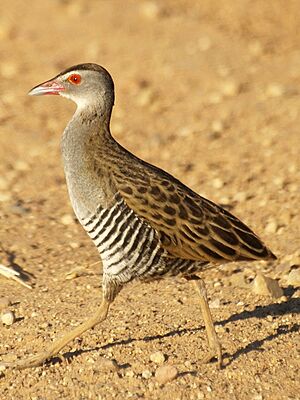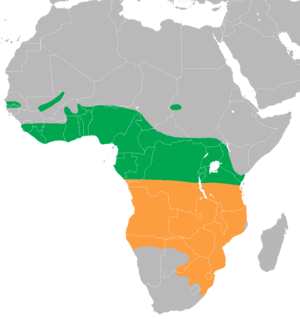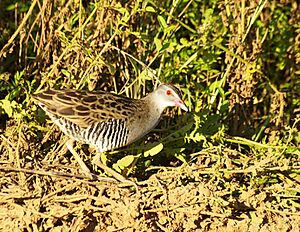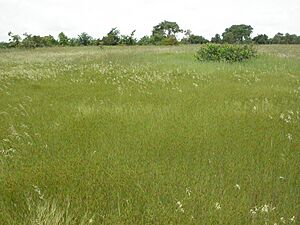African crake facts for kids
Quick facts for kids African crake |
|
|---|---|
 |
|
| On the Zaagkuildrift Road, South Africa | |
| Conservation status | |
| Scientific classification | |
| Genus: |
Crecopsis
|
| Species: |
egregia
|
 |
|
|
Breeding summer visitor
(ranges are very approximate)Resident year-round |
|
| Synonyms | |
|
Ortygometra egregia |
|
The African crake (Crecopsis egregia) is a small bird that lives on the ground. It belongs to the rail family. You can find it in most parts of central and southern Africa. This bird is common in many areas, except in very dry places or thick rainforests.
The African crake is a partial migrant. This means it moves away from the equator when the rainy season brings enough grass. This tall grass helps it hide and build nests. Sometimes, a few birds have even flown far out to Atlantic islands. This crake builds its nests in many types of grasslands. It can also live in farm fields with tall crops.
This crake is fairly small. It has brown and black stripes on its back. Its belly is bluish-grey, with black and white stripes on its sides. It has a short red beak and red eyes. A white line goes from its beak to above its eye. The African crake makes many sounds. Its most common call is a quick, grating krrr sound. It is active during the day and protects its home area. Males might even fight to defend their space. Their nest is a shallow cup made of grass leaves. It is built in a small dip under a patch of grass or a small bush. The female lays 3 to 11 eggs. The eggs hatch in about 14 days. The baby chicks are black and fluffy. They can fly after four to five weeks.
African crakes eat many small creatures without backbones, like insects. They also eat some small frogs, fish, and plants, especially grass seeds. Bigger birds, snakes, or mammals might hunt them. Even humans sometimes eat them. While farming or building can make them lose their homes, the African crake is not considered an endangered animal. This is because it lives in a very large area and there are many of them.
Contents
About the African Crake
What is the African Crake?
The African crake is part of the rail family, which has almost 150 different bird species. These birds are thought to have first appeared in the Old World (Europe, Asia, and Africa).
The scientific name for the African crake is Crecopsis egregia. It was first described in 1854 by Wilhelm Peters. For a long time, scientists thought it was closely related to the corn crake. However, new research shows that the African crake is actually more closely related to the Rouget's rail.
The name Crecopsis comes from the word Crex and an old Greek word opsis, which means "appearance." The name egregia comes from a Latin word meaning "outstanding" or "prominent."
How to Identify an African Crake
The African crake is a small bird. It is about 20 to 23 centimeters (8 to 9 inches) long. Its wings can spread out to 40 to 42 centimeters (16 to 17 inches). The male bird has dark, blackish upper parts with olive-brown stripes. The back of its neck is plain light brown. It has a white stripe that goes from its beak to above its eye.
The sides of its head, throat, and chest are bluish-grey. Its flight feathers are dark brown. The sides of its belly have black and white stripes. Its eyes are red, its beak is reddish, and its legs and feet are light brown or grey. Male and female crakes look similar, but the female is a little smaller and not as brightly colored. Young birds are darker and duller than adults.
The African crake is smaller than the corn crake. The corn crake also has darker upper parts and a plain grey face. When flying, the African crake has shorter, blunter wings and flaps them deeper than other related birds.
The Calls of the African Crake
Like other rails, the African crake makes many different sounds. The male's call to attract a mate or mark its territory is a quick, grating krrr sound. It repeats this sound two or three times per second for several minutes. It usually calls most often during the breeding season, either early in the morning or late in the day. Sometimes, it calls after dark or before dawn.
Both male and female crakes make a sharp, loud kip call. They use this sound as an alarm or when they are arguing over territory. Once they start breeding, the birds become much quieter. However, they will start making the kip call again during the non-breeding season, especially if many crakes are in the area. Baby chicks make a soft wheeeez sound, and older chicks cheep.
Where African Crakes Live
The African crake lives across Africa, south of the Sahara Desert. You can find it from Senegal in the west to Kenya in the east, and south to South Africa. It does not live in very dry areas where there is less than 300 millimeters (12 inches) of rain each year. It is common in most of its range, except in rainforests and very dry places.
This crake is a partial migrant. This means it moves around. Its movements are complicated and not fully understood. It mostly breeds during the wet season. Many birds move away from the equator when the rains make the grass tall enough for them to breed. They usually move south from November to April. They return north when fires or dry weather reduce the grass cover.
African crakes live mainly in grasslands. This includes the edges of wetlands, seasonal marshes, and savannas. They also like lightly wooded dry grasslands and grassy clearings in forests. They can also be found in fields of corn, rice, and cotton, old farmlands, and sugarcane fields near water. They prefer grass that is 0.3 to 1 meter (1 to 3 feet) tall, but they can use vegetation up to 2 meters (6.5 feet) tall.
Their grassland homes are often burned in the dry season. This forces the birds to move to other places.
African Crake Behavior
The African crake is active during the day, especially around sunset, during light rain, or after heavy rain. It is not as shy as some other crakes. You can often see it at the edges of roads and paths. If you are in a car, you might be able to get very close to it. When a bird is scared and flies away, it usually flies less than 50 meters (164 feet). It often lands in a wet area or behind a thick bush and then crouches down. In short grass, it can run very fast to escape from a dog. It runs with its body almost flat to the ground.
The African crake protects its territory (its home area) during both breeding and non-breeding seasons. When a male crake wants to scare off another bird, it stands tall and spreads the feathers on its sides and belly like a fan. This shows off its striped underparts. It might walk towards the other bird or walk side by side with another male. Females might also join in, but they don't fan their feathers as much. When male birds fight over territory, they jump at each other and peck. Female crakes will attack other females in their territory, especially if the male has shown interest in them.
Reproduction and Life Cycle

Breeding starts with the male chasing the female. The female runs in a crouch, and the male follows, standing taller with his neck stretched out. The female might stop and lower her head and tail to allow mating. This only takes a few seconds, but they might do it several times in an hour.
The nest is a shallow cup made of grass leaves. Sometimes it has a loose cover over it. It is built in a small dip and hidden under a patch of grass or a small bush. The nest can be on dry ground, slightly raised above water, or even floating. The nest is about 20 centimeters (8 inches) wide. The inside cup is 2 to 5 centimeters (0.8 to 2 inches) deep and 11 to 12 centimeters (4.3 to 4.7 inches) wide.
The female lays 3 to 11 pinkish eggs. The first egg is often laid when the nest is just a small pad of grass. Then, one more egg is laid each day. Both parents take turns sitting on the eggs to keep them warm. The eggs start hatching after about 14 days. All the chicks hatch within 48 hours, even though the eggs were laid over several days. The baby chicks are black and fluffy. They leave the nest soon after hatching, but their parents feed and protect them. They can fly after four to five weeks, even before they are fully grown. It is not known if they have a second group of babies.
What African Crakes Eat
The African crake eats many small creatures without backbones. This includes earthworms, snails, and insects like termites, ants, beetles, and grasshoppers. They might also eat small frogs or fish. They also eat plants, especially grass seeds, but also green shoots, leaves, and other seeds.
The crake looks for food both in plants and in open areas. It picks up insects and seeds from the ground, turns over fallen leaves, or digs in soft ground with its beak. It will chase fast-moving prey and reach up to get food from plants. It can also walk in water to pick up food items. Sometimes, they eat farm crops like rice, corn, and peas, but they are not considered a pest for farmers. They look for food alone, in pairs, or in family groups. Sometimes, they join other grassland birds like great snipes. Baby chicks are mostly fed animal food. Like other rails, they swallow small stones (grit) to help break down food in their stomachs.
Predators and Dangers
Large animals like leopards, servals, and cats can hunt African crakes. Birds of prey like the black-headed heron, dark chanting goshawk, African hawk-eagle, and Wahlberg's eagle also hunt them. In South Africa, a boomslang (a type of snake) was seen eating newly hatched chicks. If surprised, an African crake will jump straight up into the air before running away. This trick is thought to help them escape from snakes or land mammals.
African crakes can also have parasites. These include ticks and a type of feather mite.
Conservation Status
The African crake lives in a very large area, estimated to be 11,700,000 square kilometers (4,500,000 square miles). We don't know exactly how many there are, but they are common in most places they live. Their numbers seem to be stable. Because of this, they are listed as "Least Concern" on the IUCN Red List. This means they are not currently considered threatened.
However, some things can harm their habitat. Too much grazing by animals, farming, and the loss of wetlands and moist grasslands have reduced the places they can live in many areas. For example, some parts of the South African coast have been built up into cities or planted with sugarcane. In other areas, grasslands might have actually increased where forests have been cleared.
People in some regions also hunt African crakes for food. Despite these challenges, the African crake seems to be doing well overall.




